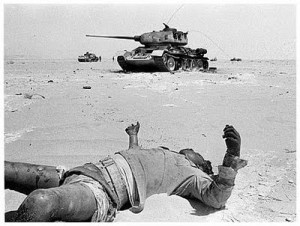 Let the images of war speak for themselves
Let the images of war speak for themselves
By Robert Fisk, Saturday, 2 April 2011
…
I hate being called a war reporter. Firstly, because there is an unhappy flavour of the junkie about it. Secondly, because you cannot report a war without knowing the politics behind it.
Could Ed Murrow or Richard Dimbleby have covered the Second World War without understanding Chamberlain’s policy of appeasement or Hitler’s Anschluss? Could James Cameron – whose reporting on Korea was spectacular – have recorded the live test-firing of an atom bomb without knowledge of the Cold War?
I always say that reporters should be neutral and unbiased on the side of those who suffer. If you were covering the 18th-century slave trade, you would not give equal space to the slave-ship captain. At the liberation of an extermination camp, you do not give equal time to the SS. When the Palestinian Islamic Jihad blew up a pizzeria full of Israeli children in Jerusalem in 2001, I did not give equal space to the Islamic Jihad spokesman. At the Sabra and Chatila massacre in Beirut in 1982, I did not give equal time to the Israeli army who watched the killings and whose Lebanese allies committed the atrocity.
But television has different priorities. “Al Jazeera English” – as opposed to the Arabic version – manages to get it about right. Yes, I occasionally make an appearance on Al Jazeera and its reporters are good friends of mine. But it does say who the bad guys are; it does speak out, and it puts the usually pusillanimous BBC to shame. What I am most struck by, however, is the quality of the reporting. Not the actual words. But the pictures.
In Tunisia and in Bahrain, I often shared a car with James Bays of Al Jazeera (and yes, he is a mate of mine, and yes, I was travelling at his expense, of course!), but I was fascinated by the way he would step aside from the camera with the words “I’ll just let you see the scene here for a moment”, and then he would disappear and let us watch the tens of thousands of Egyptian refugees on the Tunisian border or the tens of thousands of Shia demonstrators with their Bahraini flags on the Pearl roundabout (the “pearl” having now been destroyed by the king like a ritual book-burning). The pictures spoke instead of words. The reporter took a back seat (watch the BBC’s boys and girls, for ever gesticulating with their silly hands, for the opposite) and the picture told the story.
Bays himself is now covering the rebel advance and constant retreat from western Libya – more retreating, I suspect, than Generals Wavell and Klopper (yes, James, look him up) – did in the Libyan desert in the 1940s, but again, he steps aside from the picture and lets us watch the chaos of panic and fear on the road from Ajdabiya. “I’ll just let you see this with your own eyes,” he says. And by God, he does. I’m not sure this is how war should be reported. Can you report on the 1945 fall of Berlin without General Zhukov? Or June of 1940 without Churchill? But at least we are left to make up our own minds.
When Dimbleby reported on the Hamburg firestorm – “All I can see before me is a great white basin of light in the sky”, still haunts me – we needed his words. Just as we needed Ed Murrow’s comment that he would move his cable “just a bit” to allow Londoners to flock for cover outside St Martin-in-the-Fields during the Blitz. But there is something indelibly moving about a straight camera report without a reporter. Eurovision often does this – “without words”, it calls the tapes – and I wonder if it does not presage a new kind of journalism.
John Simpson tried to do this on the BBC before the fall of Kabul in 2001, but he used a different method. He allowed viewers to see his second camera crew. They became part of the dispatches as he moved from scene to scene, and slowly we got used to the idea that there was a four-man crew with him, to the point that they became natural participants in the story, as obvious as the reporter himself. I’m all for this. The idea that we still have to do “noddies” – where the reporter, long after an interview, nods meaningfully in front of the camera as if he were still listening to his long-departed interviewee – is ridiculous. And to go back for a moment, please, please, will television reporters STOP playing with their hands as if they are some Shakespearean extra, trying to explain themselves in front of bored theatre audiences.
Bays still uses his hands a bit – I noticed that I did on Al Jazeera the other day – but more often than not, it’s to invite the audience to look at something he has seen. I once wrote that you cannot describe a massacre in print without using the language of a medical report, and I fear that television (even Al Jazeera) does not yet give us the full horror of atrocities. The claim that the dead cannot be shown – when we journos have to see them in all their horror – always seems to me dissembling. If governments go to war (how many saw pictures of the Libyan dead after coalition raids this week? Answer: zero), then we should be allowed the see the true face of war.
For the moment, however, watch Al Jazeera, have a look at my good friend James Bays – and pray that he doesn’t have to retreat any more. Also, after this column, that he still lets me travel in his crews’ cars.
http://www.independent.co.uk/opinion/commentators/fisk/robert-fisk-let-the-images-of-war-speak-for-themselves-2260019.html or http://ind.pn/fINXrZ or http://tinyurl.com/3ulemzg
